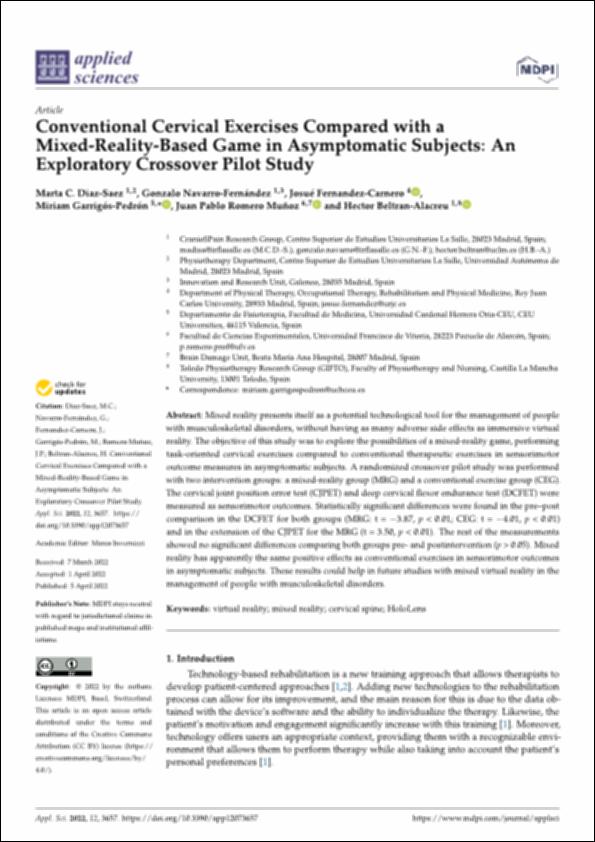Por favor, use este identificador para citar o enlazar este ítem:
http://hdl.handle.net/10637/14315Conventional cervical exercises compared with a mixed-reality-based game in asymptomatic subjects an exploratory crossover pilot study
| Título : | Conventional cervical exercises compared with a mixed-reality-based game in asymptomatic subjects an exploratory crossover pilot study |
| Autor : | Díaz Sáez, Marta C. Navarro Fernández, Gonzalo Fernández Carnero, Josué Garrigós Pedrón, Miriam Romero Muñoz, Juan Pablo Beltrán Alacreu, Héctor |
| Materias: | Virtual reality in physical theraphy.; Vértebras cervicales - Fisioterapia.; Cervical Vertebrae - Physical therapy.; Realidad virtual - Aplicaciones en fisioterapia. |
| Editorial : | MDPI |
| Citación : | Diaz-Saez, M. C., Navarro-Fernández, G., Fernandez-Carnero, J., Garrigós-Pedrón, M., Romero Muñoz, J. P. & Beltran-Alacreu, H. (2022). Conventional cervical exercises compared with a mixed-reality-based game in asymptomatic subjects: an exploratory crossover pilot study. Applied Sciences, vol. 12, i. 7 (05 apr.), art. 3657. DOI: http://dx.doi.org/10.3390/app12073657 |
| Resumen : | Mixed reality presents itself as a potential technological tool for the management of people with musculoskeletal disorders, without having as many adverse side effects as immersive virtual reality. The objective of this study was to explore the possibilities of a mixed-reality game, performing task-oriented cervical exercises compared to conventional therapeutic exercises in sensorimotor outcome measures in asymptomatic subjects. A randomized crossover pilot study was performed with two intervention groups: a mixed-reality group (MRG) and a conventional exercise group (CEG). The cervical joint position error test (CJPET) and deep cervical flexor endurance test (DCFET) were measured as sensorimotor outcomes. Statistically significant differences were found in the pre–post comparison in the DCFET for both groups (MRG: t = 3.87, p < 0.01; CEG: t = 4.01, p < 0.01) and in the extension of the CJPET for the MRG (t = 3.50, p < 0.01). The rest of the measurements showed no significant differences comparing both groups pre- and postintervention (p > 0.05). Mixed reality has apparently the same positive effects as conventional exercises in sensorimotor outcomes in asymptomatic subjects. These results could help in future studies with mixed virtual reality in the management of people with musculoskeletal disorders. |
| Descripción : | Este artículo se encuentra disponible en la siguiente URL: https://www.mdpi.com/2076-3417/12/7/3657 Este artículo de investigación pertenece al número especial "Advances in Neurorrehabilitation: VR, Noninvasive Neuromodulation, Movement Representation Strategies and Robotic Assist Devices". |
| URI : | http://hdl.handle.net/10637/14315 |
| Derechos: | http://creativecommons.org/licenses/by/4.0/deed.es |
| ISSN : | 2076-3417 (Electrónico) |
| Idioma: | es |
| Fecha de publicación : | 5-abr-2022 |
| Centro : | Universidad Cardenal Herrera-CEU |
| Aparece en las colecciones: | Dpto. Ciencias Biomédicas |
Los ítems de DSpace están protegidos por copyright, con todos los derechos reservados, a menos que se indique lo contrario.


